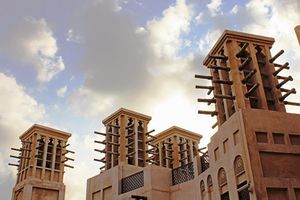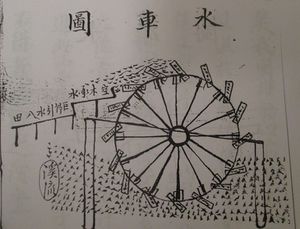What is the history of cooling a home in summer
Cooling a home has become more important for many of us during long heatwaves in the summer. While today our air conditioning bills might reflect the need to keep cool, long before such technology people practiced different methods to keep cool. Some of the techniques might even give us a few ideas to keep our homes relatively cool for less money.
Early History of Cooling
By the late 4th millennium BC or at least early 3rd millennium BC, it was evident that if people were going to live in cities then they had to figure out a way to keep cool. In Mesopotamia, modern Iraq and Syria, and Egypt the earliest cities already show evidence for cooling methods. Already by 7000 BC, homes were made of mud in the Middle East, which allowed them to stay relatively cool in the summer months. Mud insulates a home from heat seeping in during the summer, while it also acts to seal in heat during the winter. However, to live in larger cities, home also had to be designed differently. One form of design that helped things stay cool was to keep houses near each other. Cities were very compact, which helped to create more shade. This allowed many homes not to receive direct sunlight at all hours and created shade for people to move around their homes in the streets, with narrow streets around cities, while courtyards and neighboring streets would also provide shade.
The continued use of mud plaster and bricks for construction material also enabled homes to stay relatively cool by insulating homes from outside temperatures. Courtyards and alleyways between homes were used as a way for air to circulate and create a breeze, and to create cross drafts, helping to keep air flowing and create cooler conditions. Homes could also be oriented towards the direction of prevailing winds, helping air flow through the house. Ventilation was also sometimes built that encouraged trapped air to flow through the house. Two outer walls, with a small gap between the two, or a vent, would be built that would capture air and that air would be circulated around the house.[1]
Another early device known to capture wind and circulate air in houses in Iran, Egypt, and elsewhere in the ancient Near East, were wind catchers (Figure 1). These are tower-like structures, which are still used today in some regions, built to capture airflow outside that house and then that air would be brought in and downwards to the home. Clothing itself was also effective for staying cool. What may seem counter-intuitive, but wearing wool or thick clothing in summer could help cool someone in a hot place. As the person quickly sweats, air hitting that moisture, as well as possibly water added, would then make the person's skin feel cool. Encouraging sweating or using water in cloth which did not evaporate quickly could act as a coolant.
Planting vegetation also helped to keep houses cool. By planting along the walls and courtyards, this helped to produce cooler temperatures by preventing the walls from absorbing heat and plants would transpire moisture that would reduce ambient temperatures. Other strategies to stay cool was to dig houses slightly underground so that natural soil would help insulate the house from outside temperatures. This kept houses cool in the summer and warm in the winter. Already in the Bronze Age, by around 1800 BC, ice houses or ice storage areas were created so that ice could be brought in and kept in these presumably underground shelters, where the ice would be used to create either cool drinks (or even a form of ice cream) or be used to cool someone directly.[2]
The Roman period gives us some of the terminology we use for summer. For instance, the expression "dog days of summer" comes from a similar ancient Latin phrase that referred to the star Sirius, which is the brightest star in the night sky and is part of the Canis Major (Greater Dog) constellation. This star would rise high during mid-July to late August, which is the period referred to as the dog days of summer, where the rising of the dog star was considered responsible for bringing stifling heat in the summer. Many people simply went to the frigidarium, or a cold or cool pool in bath houses found in most Roman cities, during summer months. These pools would sometimes be cooled using ice brought in from the mountains and stored in underground shelters that kept ice from melting in the summer months. Some Roman houses have been found to have a system of pipes that would circulate cold water around and inside the walls or underground to help keep the entire house feeling colder. The opposite, which was circulating warm water, would be done in winter, making the Roman system a form of central heating and cooling.[3]
Later Developments
By the early Medieval period in China, around the 8th century, large rotary fans began to be developed that were powered by water (Figure 2). Some fans would even blow over water or have water combined with the rotary motion of the fan to create something akin to air conditioning by cooling air over water and then having the cool air circulate. In the 17th and 18th centuries, early experiments with fan-like systems, which were manually or water powered, were used to help ventilate large halls or even mine shafts in Europe.
By the 18th and early 19th century, several innovations began to develop. Some were simple, such as streets beginning to have more awnings installed so that more shade would be available around towns. In 1837 William Fourness began to use steam to power fans. These were large devices that were not very portable, but nevertheless steam-driven fans enabled some cooling of larger spaces. By the mid-19th century, heavy curtains began to become fashionable in homes as well as high ceilings, although these were already evident in some early Medieval homes and palaces. The curtains would block out sun light from coming into the house during the day, while high ceilings would allow the heat to move higher up and away from the occupants in a room.
In the Victorian period, house plants also became popular, which helped to reduce air temperature in homes when plants released moisture. It was during this time also that public parks became popular, which were green spaces that also were relatively cooler than other built-up areas of urban areas. These became places people would flock to during the summer to relax.[4]
Major technical innovation began in the 1880s, with the invention of the electric fan by Schuyler Wheeler. The fan was marketed by the American company Crocker & Curtis. Ceiling fans were developed at about the same time in 1882 by Philip Diehl. Many early fans used oil or kerosene to power them with central electricity later used as that became more widely available. Nevertheless, ceiling fans did not become common in homes until the 1920s, when prices for creating them dropped, including steel used in the blades, and these features started to become more common features installed in homes by builders.[5]
The Creation of Air Conditioning
Air conditioning became the main innovation for modern cooling. In 1902, Willis Carrier invented the air conditioner, with the first machine he invented also able to control humidity. Carrier used his knowledge of heating objects with steam and reversed the process so that objects became cool. Stuart W. Cramer coined the term air conditioning, where his device used water and "conditioned" it so that the moisture would then be used to create cold air.
The first house to have air conditioning was built in 1914, which was built in Minneapolis. David St. Pierre DuBose soon after created the first home with central air conditioning, by creating ducts throughout the house that would take the cold air from the air conditioning unit and blow it around the house. Refrigerators were also used in homes in the 1910s, with the first home refrigerators invented by Fred W. Wolf of Fort Wayne, Indian. Although refrigerators did not cool the home, they did allow people to store cold drinks and food, which helped to cool them during the hot summer months. In 1945, the portable air conditioning unit was created by Robert Sherman, allowing window units to be easily made and installed in older homes that did not have air conditioning.
In the 1950s, central air conditioning began to become more common and throughout much of the United States window units and central air conditioning became common. Although air conditioning certainly made many people's lives more comfortable, it did mean home builders did not always have to apply measures, such as gardening or building materials, that were always ideal for cooling, where builders could now choose cheaper materials and depend more on air conditioning to keep homes cool rather than use other measures.[6]
Summary
Many ways to keep cool have been invented, including many techniques that are cheap and effective. For instance, simply planting trees or shrubs around a house could substantially cool a home. Airblown on water was known to cool places probably already by the Bronze Age in the 3rd millennium BC, but the Romans could have been the first to capitalize on this to create something akin to a central cooling system. Electric fans in the late 19th century and air conditioning in the early 20th century have now transformed homes. However, this has meant many homes today depend more on these modern conveniences and use materials, such as concrete, that have made cooling impossible without the use of modern cooling methods.
References
- ↑ For more on early design of homes to help cool them, see: Lumpkins, William T. La Casa Adobe. Rev. and enl. ed. Santa Fe, N.M: Ancient City Press, 1986.
- ↑ For more on house designs, clothing, and wind catchers, see: Kanaani, Mitra, and David Alan Kopec, eds. The Routledge Companion for Architecture Design and Practice: Established and Emerging Trends. Routledge. New York: Routledge, Taylor & Francis Group, 2016.
- ↑ For more on how Romans helped to cool themselves and their homes, see: Sear, Frank. Roman Architecture. Ithaca, N.Y: Cornell University Press, 1983.
- ↑ For more on Medieval and early modern innovations to help cool people and homes, see: Gantz, Carroll. Refrigeration: A History. Jefferson, North Carolina: McFarland & Company, Inc., Publishers, 2015.
- ↑ For more on the invention of the electric fan, see: Morrison, Heather S. Inventors of Everyday Technology. Designing Engineering Solutions. New York: Cavendish Square, 2016, pg. 6
- ↑ For more on the history of air conditioning, see: Basile, Salvatore. Cool: How Air Conditioning Changed Everything. First edition. New York: Fordham University Press, 2014.

